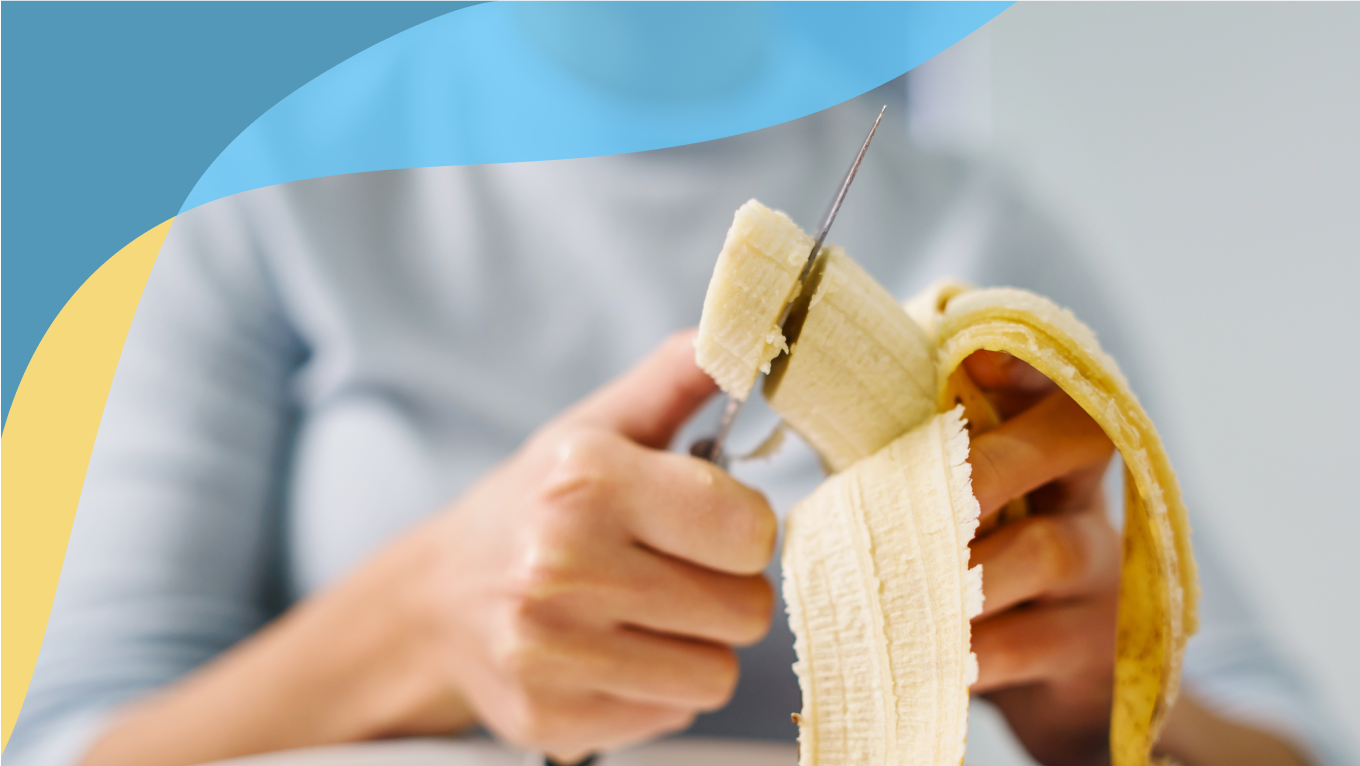
Diarrhea and Cancer: What and How to Eat
Many people living with cancer experience diarrhea — either as a side effect of treatment or a symptom of their cancer. Diarrhea can cause daily disruptions and lifestyle changes, but with preventative and nutrition-based management strategies, it can often be improved.
What is Diarrhea?
Diarrhea is defined, in relation to your normal bowel habits, as having more frequent, loose, or watery bowel movements (or “stools”). Diarrhea can range from mild to severe — meaning you might experience anywhere from 1-7 or more extra trips to the bathroom compared to your “norm.”
What Causes Diarrhea?
Diarrhea during cancer is usually caused by one or a combination of the following:
Treatments, including chemotherapy, immunotherapy and or radiation therapy
A specific type of cancer — pancreatic cancer, colon cancer, and ovarian cancer are particularly likely to cause diarrhea
Changes in diet due to cancer symptoms or treatment side effects, like eating more/less or eating different foods
Antibiotics or medications you are taking
Anxiety or stress
Other medical conditions that may be pre-existing or that arise alongside cancer or cancer treatment
6 Nutrition-Based Strategies for Managing Diarrhea
For many people living with cancer, paying close attention to what, when, and how you eat can decrease the frequency and severity of cancer-related diarrhea.
Eat a diet that’s low in fiber (less than 10 grams per day). High-fiber diets (one rich in fruits, veggies, whole grains, nuts, seeds, and legumes) are often thought of as“healthy,” though may not be the best choice if you’re dealing with diarrhea. Fiber (in large or small amounts) can irritate the intestines, so try to limit your intake to 10 grams of fiber or less per day if you’re experiencing moderate to severe diarrhea. Once the diarrhea subsides, you can gradually increase your fiber again. (For examples of low-fiber foods, see the chart below.)
Choose bland, easy-to-digest foods. If you’re experiencing diarrhea, shift your diet to include mainly foods that are more bland and easy to digest. Choosing all-natural, minimal-ingredient foods like what you might eat when you have the stomach flu can help ensure you’re not irritating your digestive system with high-fat, greasy, harsh, spicy, or complex foods that can worsen diarrhea. Make sure the foods you choose represent a wide variety of food groups so that you’re getting well-balanced nutrition. (For examples of bland, easy-to-digest foods, see the chart below.)
Eat small, frequent, slow, and strategically timed meals. Rather than eating three large meals, try eating 5-6 smaller meals and/or snacks throughout the day. Smaller amounts of food are sometimes easier for your body to digest and can help avoid overwhelming your digestive system (which in turn triggers diarrhea). Change up your behaviors around meals and snacks to further aid digestion: adjust the timing of your meals and snacks to figure out what works for you and avoid eating too close to bedtime. Also, avoid eating quickly and make sure that you are thoroughly chewing your food before you swallow it.
Avoid extreme temperatures. Eating foods that are extremely hot or extremely cold can irritate your digestive system and leave you at risk of having diarrhea. Stick to a small, happy medium range of temperatures instead.
Avoid non-food irritants. Certain substances are more likely to cause digestive irritation and diarrhea. Avoid tobacco, alcohol, and sugar-free products that contain sorbitol, mannitol, or xylitol.
Stay hydrated. Diarrhea can cause dehydration. Avoid this dangerous side effect by drinking at least 8 cups of fluid each day — sipping them slowly to avoid overwhelming your digestive system. Except for alcohol, all fluids count towards your daily goal including water, juice, electrolyte beverages (like Pedialyte or Gatorade), broth, carbonated beverages, herbal teas, and anything that melts (like juice bars, popsicles, or crushed ice).
Good to know: to prevent dehydration after an episode of diarrhea, aim to drink at least 8 ounces of fluid in the 1-2 hours after to replenish the liquid your body lost. Avoid caffeinated beverages whenever possible, as these can also lead to dehydration.
What to Eat
Below is a list of foods we recommend in the various food groups for patients experiencing diarrhea. Eliminating “avoid” foods may help in relieving or preventing diarrhea.
Food Group | We recommend EATING... | We recommend AVOIDING... |
|---|---|---|
Fruits | The following fruits, cooked and softened: Apples Cherries Blueberries Peaches Nectarines Pears Plums Pineapple Apricots Fruit Cocktail The following fruits, raw: Applesauce Avocado Bananas Melons – cantaloupe, honeydew, watermelon (without the seeds) | All raw fruits except those listed to the left Dried fruits Fruits with skins Fruits with seeds that can’t be removed – strawberries, raspberries, blackberries, kiwi Prune juice |
Vegetables | The following vegetables, cooked, peeled, and with seeds removed: Asparagus tips Beets Butternut squash Carrots Cucumbers Eggplant Green beans Mushrooms Potatoes Sweet potatoes Spaghetti squash Summer squash Zucchini Wax beans Tomatoes | Artichokes Legumes (kidney, black, pinto, chickpeas, lentils) Broccoli Brussels sprouts Cauliflower Cabbage Green leafy vegetables (greens, spinach, etc.) Peas Corn Peppers Onions Salads |
Bread and Crackers | Refined flour breads, including the following: White bread Sourdough Light rye without seeds French bread without seeds on the crust Potato bread Oatmeal bread White flour bagels, English muffins pita bread, and tortillas Crackers made with white flour, like saltines, Ritz, oyster crackers, soda crackers, rice cakes, original (plain) Melba toast | Bread products made with bran; whole wheat and other whole grains; cracked or sprouted wheat; and breads made with dried fruit, seeds, or nuts Doughnuts Croissants |
Cereals, Rice, and Pastas | Low-fiber cereals, including the following: Rice and Corn Chex Cornflakes Special K without dried fruit Puffed rice Rice Krispies Cheerios Oat Squares Oatmeal Cream of Wheat or Rice Farina Grits White rice Regular pasta, orzo, couscous | High-fiber cereals made with whole grains, bran, nuts, seeds (including flaxseeds), berries and dried fruits; granola; wheat germ Brown or wild rice Quinoa, barley, farro, amaranth Whole grain pasta and couscous |
Proteins | Lean beef or pork (loin, round or flank cuts, or 90% lean) Skinless chicken or turkey Fish and shellfish Lamb Veal Liver Eggs Creamy nut butter (peanut, almond, cashew, sunflower) Low-fat cheese Tofu | Chicken and turkey skin Fatty meats Fatty luncheon meats, like bologna, mortadella, salami Hot dogs Bacon and sausages Whole nuts and seeds Chunky nut butters |
Milk and Milk Products | 1% low-fat or non-fat milk 1% low-fat or nonfat regular or Greek yogurt Reduced-fat cheese with 6-7 grams of fat per ounce, such as American cheese, light cheddar, feta cheese, goat cheese, Babybel, and Laughing Cow Pudding Soy and other plant-based beverages (almond, cashew, rice, coconut, and pea protein milks) | Cream Creamed soups Chocolate and other flavored milks Whipped cream *Some people find that they need to avoid dairy products altogether when they have diarrhea because their body has a hard time tolerating the lactose contained in those products. |
Fats | Small amounts of vegetable oil, tub spreads (Smart Balance, Olivio, Earth Balance), butter, and mayonnaise | Fried foods Gravy Shortening Large amounts of oil, tub spread, butter, or mayonnaise |
Desserts | Low-fat desserts like angel food cake, vanilla wafers, and others with less than 3 grams of fat per serving, gelatin, pudding, sherbet, and sorbet | High-fat desserts like frosted cakes, coffee cakes, pies, ice cream, higher-fat cookies, and desserts made with nuts, seeds, coconut, dried fruit, or fruits with skins |
Spices and Condiments | Mild spices like salt, ginger, dried thyme, rosemary, or chives Black pepper as tolerated | Cayenne pepper, chili powder, chili peppers, garlic and spicy sauces |
More Ways to Manage Diarrhea
In addition to changing what and how you eat, you might also try one or more of the following to prevent and manage diarrhea during cancer:
Medication: Your doctor or Iris team may be able to prescribe an anti-diarrheal (or help you determine if you should buy one over the counter)
Symptom Tracking: Tracking your cancer-related symptoms can help you and your doctor better understand the cause of your diarrhea and try new management strategies based on that information. Start tracking today!
Communicating with Your Care Team
Even if mild, cancer-related diarrhea can have a major impact on quality of life. In severe cases, diarrhea can be dangerous and can cause dehydration, electrolyte problems, weight loss, and infections amongst other potential issues. If you’re having any of the following symptoms, contact your Iris nurse or call your doctor immediately to get help and advice on the next steps:
A fever of 100.4 degrees Fahrenheit (38 degrees Celsius) or higher
Moderate to severe abdominal cramping, pain, straining, or bloating that’s causing discomfort or major life disruptions
Dizziness or confusion (this could indicate significant dehydration)
Dark urine (this means your urine is concentrated, and could indicate significant dehydration)
Black or bloody stools
If dietary measures and medications do not improve the diarrhea
Given the potential for life-threatening complications, it’s important to communicate with your care team about any new or worsening diarrhea throughout your cancer — no matter how mild it may seem. Consider tracking your diarrhea along with any other symptoms/side effects so that you have concrete information to share with your doctor about timing and severity. Your medical team will monitor your weight and electrolytes to determine if you’d benefit from any extra supportive care, treatment changes, or additional medications.
The Iris Care Team is available to support you if you’re dealing with diarrhea during cancer. Message one of our nurses now or book a nutrition visit to gain personalized strategies for using nutrition to manage this and other side effects of cancer.
This article meets Iris standards for medical accuracy. It has been fact-checked by the Iris Clinical Editorial Board, our team of oncology experts who ensure that the content is evidence based and up to date. The Iris Clinical Editorial Board includes board-certified oncologists and pharmacists, psychologists, advanced practice providers, licensed clinical social workers, oncology-certified nurses, and dietitians.
Copyright © 2025 OncoHealth. All rights reserved. All materials on these pages are the property of OncoHealth. The information and other content on this website are for information purposes only. If you have any questions about your diagnosis or treatment, please seek the advice of your physician or other qualified health care provider(s).
